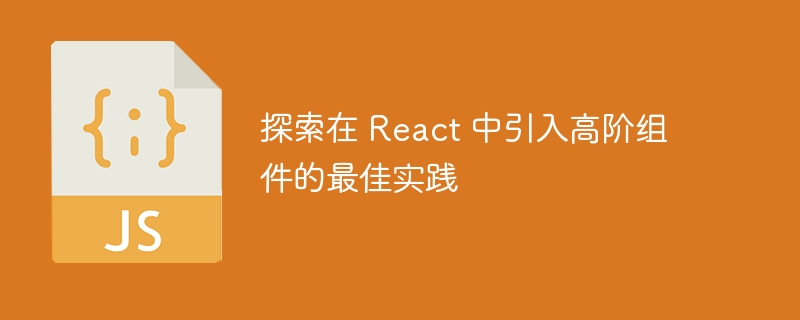探索在 React 中引入高阶组件的最佳实践

这是高阶组件系列的第三部分。在第一个教程中,我们从零开始。我们学习了 ES6 语法、高阶函数和高阶组件的基础知识。
高阶组件模式对于创建抽象组件非常有用 - 您可以使用它们与现有组件共享数据(状态和行为)。在本系列的第二部分中,我演示了使用此模式的代码的实际示例。这包括受保护的路由、创建可配置的通用容器、将加载指示器附加到组件等。
在本教程中,我们将了解您在编写 HOC 时应该考虑的一些最佳实践和注意事项。
简介
React 之前有一个名为 Mixins 的东西,它与 React.createClass 方法配合得很好。 Mixins 允许开发人员在组件之间共享代码。然而,它们有一些缺点,这个想法最终被放弃了。 Mixin 没有升级为支持 ES6 类,Dan Abramov 甚至写了一篇深入的文章来解释为什么 Mixin 被认为是有害的。
高阶组件作为 Mixins 的替代品出现,并且它们支持 ES6 类。此外,HOC 不需要对 React API 做任何事情,并且是一种与 React 配合良好的通用模式。然而,HOC 也有缺陷。尽管高阶组件的缺点在较小的项目中可能并不明显,但您可以将多个高阶组件链接到单个组件,如下所示。
const SomeNewComponent =
withRouter(RequireAuth(LoaderDemo(GenericContainer(CustomForm(Form)))))
您不应该让链接发展到您问自己这样的问题:“这些道具从哪里来?”本教程解决了高阶组件模式的一些常见问题以及正确解决这些问题的解决方案。
HOC 的问题
与 HOC 相关的一些常见问题与 HOC 本身关系不大,而与它们的实现有关。
正如您所知,HOC 非常适合代码抽象和创建可重用代码。然而,当你堆叠了多个 HOC 时,如果某些东西看起来不合适或者某些 props 没有显示,那么调试起来就会很痛苦,因为 React DevTools 为你提供的有关可能出现问题的线索非常有限。
现实世界的 HOC 问题
为了了解 HOC 的缺点,我创建了一个示例演示,其中嵌套了我们在上一教程中创建的一些 HOC。我们有四个高阶函数包装单个 ContactList 组件。如果代码没有意义或者您没有遵循我之前的教程,这里是其工作原理的简短摘要。
withRouter 是一个 HOC,是 React-router 包的一部分。它使您可以访问历史对象的属性,然后将它们作为道具传递。
withAuth 查找 authentication 属性,如果身份验证为 true,则呈现 WrappedComponent。如果身份验证为 false,则会将 '/login' 推送到历史对象。
withGenericContainer 除了 WrappedComponent 之外还接受一个对象作为输入。 GenericContainer 进行 API 调用并将结果存储在状态中,然后将数据作为 props 发送到包装的组件。
withLoader 是一个附加加载指示器的 HOC。指示器旋转,直到获取的数据达到状态。
BestPracticeDemo.jsx
class BestPracticesDemo extends Component {
render() {
return(
<div className="contactApp">
<ExtendedContactList authenticated = {true} {...this.props} contacts ="this" />
</div>
)
}
}
const ContactList = ({contacts}) => {
return(
<div>
<ul>
{contacts.map(
(contact) => <li key={contact.email}>
<img src={contact.photo} style="max-width:90%" height="100px" alt="探索在 React 中引入高阶组件的最佳实践" />
<div className="contactData">
<h4 id="contact-name">{contact.name}</h4>
<small>{contact.email}</small> <br/><small> {contact.phone}</small>
</div>
</li>
)}
</ul>
</div>
)
}
const reqAPI = {reqUrl: 'https://demo1443058.mockable.io/users/',
reqMethod:'GET', resName:'contacts'}
const ExtendedContactList = withRouter(
withAuth(
withGenericContainer(reqAPI)(
withLoader('contacts')
(ContactList))));
export default BestPracticesDemo;
现在您可以亲眼看到高阶组件的一些常见陷阱。让我们详细讨论其中的一些内容。
基本注意事项
不要忘记在 HOC 中传播道具
假设我们在组合层次结构的顶部有一个 authenticated = { this.state.authenticated } 属性。我们知道这是一个重要的道具,并且应该将其一直延伸到演示组件。然而,想象一下中间 HOC,例如 withGenericContainer,决定忽略它的所有 props。
//render method of withGenericContainer
render() {
return(
<WrappedComponent />
)
}
这是一个非常常见的错误,在编写高阶组件时应该尽量避免。不熟悉 HOC 的人可能会发现很难弄清楚为什么所有的 props 都丢失了,因为很难隔离问题。所以,永远记住在你的 HOC 中传播 props。
//The right way
render() {
return(
<WrappedComponent {...this.props} {...this.state} />)
}
不要传递超出 HOC 范围的不存在的 props
HOC 可能会引入 WrappedComponent 可能没有任何用处的新属性。在这种情况下,传递仅与组合组件相关的 props 是一个很好的做法。
高阶组件可以通过两种方式接受数据:作为函数的参数或作为组件的 prop。例如, authenticated = { this.state.authenticated } 是一个 prop 示例,而在 withGenericContainer(reqAPI)(ContactList) 中,我们传递数据作为参数。
因为 withGenericContainer 是一个函数,所以您可以根据需要传入任意数量的参数。在上面的示例中,配置对象用于指定组件的数据依赖性。然而,增强组件和包装组件之间的契约是严格通过 props 进行的。
因此,我建议通过函数参数填充静态时间数据依赖项,并将动态数据作为 props 传递。经过身份验证的道具是动态的,因为用户可以通过身份验证,也可以不通过身份验证,具体取决于他们是否登录,但我们可以确定 reqAPI 对象的内容不会动态更改。
不要在渲染方法中使用 HOC
这是一个您应该不惜一切代价避免的示例。
var OriginalComponent = () => <p>Hello world.</p>;
class App extends React.Component {
render() {
return React.createElement(enhanceComponent(OriginalComponent));
}
};
除了性能问题之外,您还将在每次渲染时丢失 OriginalComponent 及其所有子组件的状态。要解决这个问题,请将 HOC 声明移到 render 方法之外,使其仅创建一次,以便渲染始终返回相同的EnhancedComponent。
var OriginalComponent = () => <p>Hello world.</p>;
var EnhancedComponent = enhanceComponent(OriginalComponent);
class App extends React.Component {
render() {
return React.createElement(EnhancedComponent);
}
};
不要改变包装组件
改变 HOC 内的包装组件将导致无法在 HOC 外部使用包装组件。如果您的 HOC 返回 WrappedComponent,您几乎总是可以确定自己做错了。下面的例子演示了突变和组合之间的区别。
function logger(WrappedComponent) {
WrappedComponent.prototype.componentWillReceiveProps = function(nextProps) {
console.log('Current props: ', this.props);
console.log('Next props: ', nextProps);
};
// We're returning the WrappedComponent rather than composing
//it
return WrappedComponent;
}
组合是 React 的基本特征之一。您可以在其渲染函数中将一个组件包装在另一个组件内,这就是所谓的组合。
function logger(WrappedComponent) {
return class extends Component {
componentWillReceiveProps(nextProps) {
console.log('Current props: ', this.props);
console.log('Next props: ', nextProps);
}
render() {
// Wraps the input component in a container, without mutating it. Good!
return <WrappedComponent {...this.props} />;
}
}
}
此外,如果您改变 HOC 内的 WrappedComponent,然后使用另一个 HOC 包装增强组件,则第一个 HOC 所做的更改将被覆盖。为了避免这种情况,您应该坚持组合组件而不是改变它们。
命名空间通用 Propnames
当您有多个堆叠时,命名空间道具名称的重要性是显而易见的。组件可能会将 prop 名称推送到已被另一个高阶组件使用的 WrappedComponent 中。
import React, { Component } from 'react';
const withMouse = (WrappedComponent) => {
return class withMouse extends Component {
constructor(props) {
super(props);
this.state = {
name: 'Mouse'
}
}
render() {
return(
<WrappedComponent {...this.props} name={this.state.name} />
);
}
}
}
const withCat = (WrappedComponent) => {
return class withCat extends Component {
render() {
return(
<WrappedComponent {...this.props} name= "Cat" />
)
}
}
}
const NameComponent = ({name}) => {
return(
<div> {name} </div>)
}
const App =() => {
const EnhancedComponent = withMouse(withCat(NameComponent));
return(
<div> <EnhancedComponent /> </div>)
}
export default App;
withMouse 和 withCat 都在尝试推送自己的 name 版本。如果EnhancedComponent也必须共享一些同名的props怎么办?
<EnhancedComponent name="This is important" />
这不会给最终开发人员带来混乱和误导吗? React Devtools 不会报告任何名称冲突,您必须查看 HOC 实现细节才能了解出了什么问题。
这可以通过提供 HOC 属性名称的范围作为约定来解决。因此,您将拥有 withCat_name 和 withMouse_name 而不是通用的 prop 名称。
这里需要注意的另一件有趣的事情是,对属性进行排序在 React 中非常重要。当您多次拥有相同的属性并导致名称冲突时,最后一个声明将始终保留。在上面的例子中,Cat 获胜,因为它被放置在 { ...this.props } 之后。
如果您希望通过其他方式解决名称冲突,您可以重新排序属性并在最后传播 this.props 。这样,您就可以设置适合您的项目的合理默认值。
使用有意义的显示名称使调试更容易
由 HOC 创建的组件在 React Devtools 中显示为普通组件。很难区分两者。您可以通过为高阶组件提供有意义的 displayName 来简化调试。在 React Devtools 上拥有这样的东西不是明智的吗?
<withMouse(withCat(NameComponent)) > ... </withMouse(withCat(NameComponent))>
那么 displayName 是什么?每个组件都有一个 displayName 属性,可用于调试目的。最流行的技术是包装 WrappedComponent 的显示名称。如果 withCat 是 HOC,并且 NameComponent 是 WrappedComponent,则 displayName 将是 withCat(NameComponent).
const withMouse = (WrappedComponent) => {
class withMouse extends Component {
/* */
}
withMouse.displayName = `withMouse(${getDisplayName(WrappedComponent)})`;
return withMouse;
}
const withCat = (WrappedComponent) => {
class withCat extends Component {
/* */
}
withCat.displayName = `withCat(${getDisplayName(WrappedComponent)})`;
return withCat;
}
function getDisplayName(WrappedComponent) {
return WrappedComponent.displayName || WrappedComponent.name || 'Component';
}
高阶组件的替代方案
尽管 Mixins 已经消失,但说高阶组件是唯一允许代码共享和抽象的模式是有误导性的。另一种替代模式已经出现,我听说有人说它比 HOC 更好。深入探讨这个概念超出了本教程的范围,但我将向您介绍渲染道具和一些基本示例,以演示它们为何有用。
渲染道具有许多不同的名称:
- 渲染道具
- 儿童道具
- 像孩子一样发挥作用
- 渲染回调
这是一个简单的示例,应该解释渲染道具的工作原理。
class Mouse extends Component {
constructor() {
super();
this.state = {
name: "Nibbles"
}
}
render() {
return(
<div>
{this.props.children(this.state)}
</div>
)
}
}
class App extends Component {
render() {
return(
<Mouse>
{(mouse) => <div> The name of the mouse is {mouse.name} </div> }
</Mouse>
)
}
}
如您所见,我们已经摆脱了高阶函数。我们有一个名为 Mouse 的常规组件。我们将渲染 this.props.children() 并将状态作为参数传递,而不是在其 render 方法中渲染包装的组件。所以我们给 Mouse 一个 render prop,而 render prop 决定应该渲染什么。
换句话说,Mouse 组件接受一个函数作为子属性的值。当 Mouse 渲染时,它返回 Mouse 的状态,并且 render prop 函数可以随意使用它。
我喜欢这种模式的几点:
- 从可读性的角度来看,道具的来源更加明显。
- 这种模式是动态且灵活的。 HOC 是在静态时间组成的。尽管我从未发现这是一个限制,但渲染道具是动态组合的并且更加灵活。
- 简化的组件组成。您可以告别嵌套多个 HOC。
结论
高阶组件是可用于在 React 中构建健壮、可重用组件的模式。如果您要使用 HOC,则应遵循一些基本规则。这是为了让您以后不会后悔使用它们的决定。我在本教程中总结了大部分最佳实践。
HOC 并不是当今唯一流行的模式。在本教程的最后,我向您介绍了另一种称为渲染道具的模式,该模式在 React 开发人员中越来越受欢迎。
我不会判断一种模式并说这个模式比另一个模式更好。随着 React 的发展以及它周围的生态系统的成熟,越来越多的模式将会出现。在我看来,您应该学习所有这些,并坚持选择适合您的风格并且您感到舒服的一个。
这也标志着高阶组件教程系列的结束。我们已经从零开始,掌握了一种称为 HOC 的先进技术。如果我错过了任何内容或者您有建议/想法,我很乐意听到。您可以将它们发布在评论中。
以上是探索在 React 中引入高阶组件的最佳实践的详细内容。更多信息请关注PHP中文网其他相关文章!

热AI工具

Undresser.AI Undress
人工智能驱动的应用程序,用于创建逼真的裸体照片

AI Clothes Remover
用于从照片中去除衣服的在线人工智能工具。

Undress AI Tool
免费脱衣服图片

Clothoff.io
AI脱衣机

AI Hentai Generator
免费生成ai无尽的。

热门文章

热工具

记事本++7.3.1
好用且免费的代码编辑器

SublimeText3汉化版
中文版,非常好用

禅工作室 13.0.1
功能强大的PHP集成开发环境

Dreamweaver CS6
视觉化网页开发工具

SublimeText3 Mac版
神级代码编辑软件(SublimeText3)

热门话题
 如何在浏览器中优化JavaScript代码以进行性能?
Mar 18, 2025 pm 03:14 PM
如何在浏览器中优化JavaScript代码以进行性能?
Mar 18, 2025 pm 03:14 PM
本文讨论了在浏览器中优化JavaScript性能的策略,重点是减少执行时间并最大程度地减少对页面负载速度的影响。
 如何使用浏览器开发人员工具有效调试JavaScript代码?
Mar 18, 2025 pm 03:16 PM
如何使用浏览器开发人员工具有效调试JavaScript代码?
Mar 18, 2025 pm 03:16 PM
本文讨论了使用浏览器开发人员工具的有效JavaScript调试,专注于设置断点,使用控制台和分析性能。
 谁得到更多的Python或JavaScript?
Apr 04, 2025 am 12:09 AM
谁得到更多的Python或JavaScript?
Apr 04, 2025 am 12:09 AM
Python和JavaScript开发者的薪资没有绝对的高低,具体取决于技能和行业需求。1.Python在数据科学和机器学习领域可能薪资更高。2.JavaScript在前端和全栈开发中需求大,薪资也可观。3.影响因素包括经验、地理位置、公司规模和特定技能。
 如何使用源地图调试缩小JavaScript代码?
Mar 18, 2025 pm 03:17 PM
如何使用源地图调试缩小JavaScript代码?
Mar 18, 2025 pm 03:17 PM
本文说明了如何使用源地图通过将其映射回原始代码来调试JAVASCRIPT。它讨论了启用源地图,设置断点以及使用Chrome DevTools和WebPack之类的工具。
 如何使用JavaScript将具有相同ID的数组元素合并到一个对象中?
Apr 04, 2025 pm 05:09 PM
如何使用JavaScript将具有相同ID的数组元素合并到一个对象中?
Apr 04, 2025 pm 05:09 PM
如何在JavaScript中将具有相同ID的数组元素合并到一个对象中?在处理数据时,我们常常会遇到需要将具有相同ID�...
 神秘的JavaScript:它的作用以及为什么重要
Apr 09, 2025 am 12:07 AM
神秘的JavaScript:它的作用以及为什么重要
Apr 09, 2025 am 12:07 AM
JavaScript是现代Web开发的基石,它的主要功能包括事件驱动编程、动态内容生成和异步编程。1)事件驱动编程允许网页根据用户操作动态变化。2)动态内容生成使得页面内容可以根据条件调整。3)异步编程确保用户界面不被阻塞。JavaScript广泛应用于网页交互、单页面应用和服务器端开发,极大地提升了用户体验和跨平台开发的灵活性。








